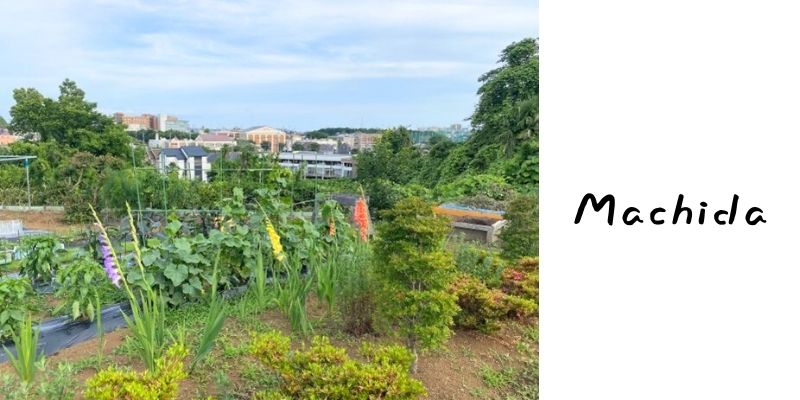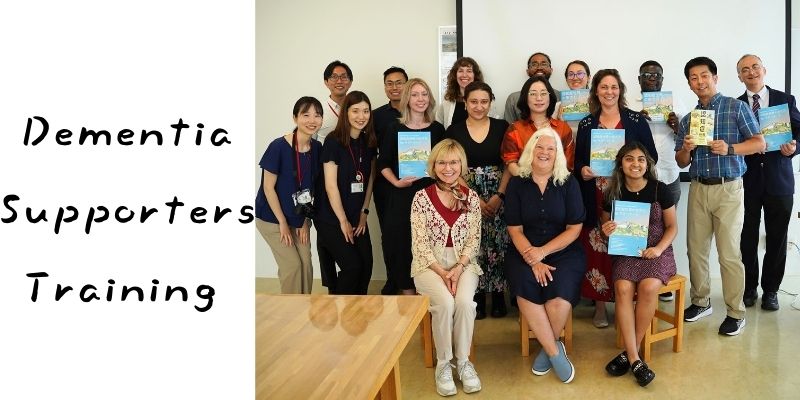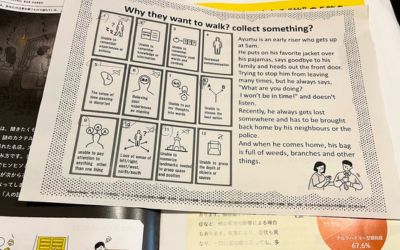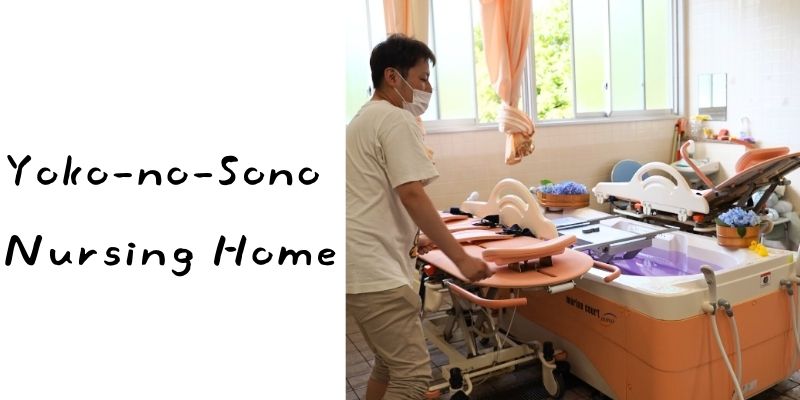September 2024
According to the most recent data from the U.S. Census, the number of Americans age 65 and older is expected to nearly double over the next four decades. As the United States faces an increasingly aging population, graduate students from the University System of Maryland are looking to Japan for solutions to improve the quality of our citizens’ later years.
For two weeks in June, a group of 11 University of Maryland, Baltimore (UMB) and University of Maryland, Baltimore County (UMBC) students visited Kanagawa Prefecture, Japan’s second-largest metropolitan area and a sister state to Maryland, where they studied the country ’s approach to healthy aging and elder care.
The faculty-led trip, part of the Global Health Aging: Gerontology in Japan course that is offered through the University of Maryland School of Graduate Studies, explored aging and life transition in Japan, a country with one of the oldest populations on the planet.
“Japan is a super-aged society, with nearly 30 percent of its population over 65," said Diane Martin, PhD, MA, director of the Geriatrics and Gerontology Education and Research Program (GGEAR) at the School of Graduate Studies. “They've been projecting this demographic shift since the 1980s. We want students to see some of those initiatives in action."
The interdisciplinary group included students studying gerontology, medicine, palliative care, social work, neuroscience, and emergency and integrative health. During their travels, they visited academic research centers, businesses, health care facilities, government offices, and cultural sites to gain a comprehensive understanding of aging in Japan.
Faculty members included trip leaders Martin and Takashi Yamashita, PhD, MPH, MA, director of the PhD Gerontology program at UMBC, plus Diane Hoffmann, JD, MS, Jacob A. France Professor of Health Law, University of Maryland Francis King Carey School of Law, and Denise Orwig, PhD, gerontology professor, University of Maryland School of Medicine.
“One of the most impressive things was how engaged older adults are in Japanese society,” said Alfred Boakye, MA, MPhil, a gerontology PhD candidate in the GGEAR program. “They have a concept called ME-BEYO where they attempt to bridge the gap between health and frailty with nutrition, exercise, and social connection. It runs through all their policies and helps to keep older people involved in the community.”
The students also learned about Japan’s innovative dementia education program, which teaches children, government employees, caregivers, and family members about the condition that is expected to affect one third of the country’s population by 2060, according to statistics from the National Institutes of Health.
Martin hopes to bring some of Japan’s best practices back to Maryland, particularly the emphasis on keeping older adults engaged and the government’s collaborative approach to healthy aging.
“The lessons we learned can help inform our own efforts to support an aging population and ensure a higher quality of life for older adults,” she said.

June 8, 2024
My first day in Japan was as expected: rainy and humid. Despite the weather, nothing could dampen my mood as I returned to a place I had called home from 2019-2021. Japan will always have a special place in my heart, and I am so incredibly excited to see it through the lens of gerontology. Being able to combine my medical background with my prior experiences here is an opportunity I’ve very much looked forward to. Living and working in Tokyo allowed me to see the infrastructure and support that aging adults are given, and in turn they are much more visible and integrated in society here when compared with the US.
Once I got to the hotel, my first stop was 7-11 to grab some onigiri (rice balls) for an early dinner. Despite my excitement, the 14-hour time difference kicked in and I went to bed. The next morning, jet lag woke me up at 5:30, so I got to roam the quiet streets of Tokyo before the hustle and bustle began. I grabbed an iced coffee (from 7-11 again, of course) and strolled as the morning commuters rushed to their destinations. The sun rises around 4:30 a.m. in the summer here, so early mornings don’t feel quite so early. Once the world also woke up, I hopped on the train to do some exploring before my program started. I visited Machida, the town on the outskirts of Tokyo I used to teach in and saw some old friends.
Now my colleagues and classmates are all touching down in Japan as I write this! The day has finally come for us to start our program, and I am incredibly excited!
Sara Chang
Second-Year Student, School of Medicine
.jpg)
June 9, 2024
Today is a day of anticipation and excitement for our teams. The sunrise in Tokyo occurred at 4:25 a.m., while in Baltimore it was at 5:40 a.m.! Japan does not observe daylight savings time, so the day here is much longer, with numerous active hours. Many of us are landing at Haneda Airport, a bustling hub of activity, and many have already touched down and are making their way to the vibrant city of Yokohama. A very few of us landed a day or two earlier. The first impression of the country is nothing short of fascinating. We’re all looking forward to the team-building activities and cultural experiences that await us in the coming days.
The food is incredible! I ordered a Hiroshimayaki topped with beef tendon, Kujo green onion, and pork. What a savoring dish. The man who waited on my table for lunch was evidently an older adult. Seeing an older adult wait on restaurant tables is quite a rarity back where I live in the U.S. It is incredible how he stayed active. We could not communicate in one language, and he was quite busy with other tables calling for his attention.
Not until later in the day was I walking in the Yokohama area near the mall. Here was someone diligently sweeping the curb outside the shopping center. What a pleasant older man! I hope to see him again, as the shopping area is fairly close to the hotel. This cultural difference in work dynamics, where age is not a barrier to active work, is fascinating about work ethics in Japan.
Since I landed earlier, I decided to navigate the subway system independently, which is quite a maze. At one point, an older lady, who must have been in her late 90s and holding a cane, boarded the train. I was so impressed to see her choosing to take the train, a mode of transportation that requires more effort and independence, rather than opting for a more convenient option. Taking the train here requires extensive walking, at times, and navigating a very complex underground system. This moment indeed highlighted the inspiring resilience and independence of the Japanese people.
As I reflect on the day, I can’t help but wonder about the cultural factors contributing to the vitality and longevity of the Japanese people. The early rises, light stimulating the body and mind, the long days, the long hours people work, and the longer years they spend working. This keeps a sense of purpose and goals to strive for. Could that be a reason why people age well in Japan? Is it because they are challenged to stay awake longer and accomplish more? What can we learn from this cultural perspective on aging? The energy here is great. I’m thrilled about the more adventurous days ahead as we unite as a complete team tomorrow afternoon. I can’t wait to share more of these exciting experiences with my team.
Daniel Z. Mansour, PharmD, AGSF, BCGP, FASCP
MS Palliative Care Student, School of Graduate Studies
.jpg)
June 10, 2024
Today was our first official day for the program. Although others had arrived earlier, it was our first time coming together as a group in Japan. In the morning, some of us were able to explore the surrounding area by train, and in the afternoon we all visited the governor of Kanagawa Prefecture, Kuroiwa Yuji. As the governor and his team presented to us the policies and initiatives for the Kanagawa prefecture, I was reminded of the strong cultural values that influence these programs. One of the important lessons we learned before arriving was that Japanese culture values the group first and then the individual as a unit of society on a familial level and within local communities. This is what allows the country to have health care as a right in their constitution.
Nevertheless, the governor’s office is aware of the eminent issues that their current system has in order to be sustained with an aging population. They emphasized the need to prioritize healthy aging by promoting a healthy diet, exercise, and social activity. This is why they have multiple initiatives that aim to prevent the onset of chronic diseases as people age but also to create a vibrant INOCHI. This concept of INOCHI resonated with me because it prioritized the human experience as needing community, purpose, and laughter, among other things. To promote social activities, such as a senior theater project, they have many partnerships with local businesses as well as organizations all over the world, including Maryland and the World Health Organization, to name a few. It was wondrous to see the emphasis on caring after one another as human beings first and foremost. I look forward to seeing how these values are reflected in the universities and facilities in the prefecture. To finish the day, we all walked to the nearby Yokohama Chinatown. The structures were beautiful, and the food smelled amazing. Overall, a great day to start off the itinerary!
Francy Cabrera Paz
Master of Public Health Student, School of Medicine
.jpg)
June 11, 2024
In between site visits today, we had delicious lunch at Forte restaurant located between our first site visit to the Life Innovation Center and our final visit of the day to Kanagawa University’s School of Health Innovation. As a restaurant whose mission is to employ the disabled, Forte is not your typical lunch spot, and the experience tied into today’s themes of accessibility and accommodation in promoting collaborative work.
After learning about Kanagawa Prefecture’s ME-BYO health campaign yesterday, we were introduced to the Life Innovation Center, a large-scale campus integrating private business, government assistance, and third-party facilitation of shared health, medical, and biotech research and development.
After lunch, we were welcomed by faculty, staff, and students to the School of Health Innovation, a 9-years-young graduate division of Kanagawa University. All the programs and research initiatives we were introduced to ubiquitously supported Kanagawa Prefecture’s governmental goal of creating a healthy society in which each entity has a role and purpose in support of broader well-being. The lesson of today, as cheesy as it may sound, is the value of working together to achieve big goals. We are all looking forward to learning more and experiencing the wonders of Japan!
Alyson Dodson
MA Applied Sociology Student, UMBC
.jpg)
June 12, 2024
Today we had an incredible visit to the Robo Care Center to discuss the use of the Hybrid Assistive Limb (HAL). We were shown the different applications for this technology. It has uses not only for strength and gait training in older adults, but also for rehabilitation from spinal cord injuries. It was amazing to see Abby connected to the system and gaining basic control of the system after a short calibration period. We saw several examples of use of the full HAL and the lumbar system. The results were very impressive, as after several training sessions their movements were stronger and quicker even without the device. It was amazing to see this technology and imagine ways that it could be applied in medicine, rehabilitation, and labor.
In the afternoon, we attended a meet-and-greet with our colleagues at Keio University. We exchanged presentations on our interests and current projects. The energy in the room was simply amazing. They met us with sincere desire to connect and snacks! I felt that we got to know them well even though we only had a short time together. Hopefully the relationship continues even after we return to the Unites States. Full to the brim with excitement and the possibility of future collaborations, we move on to Day 4!
Anthony Chin Loy
Master’s of Public Health Student, School of Medicine

June 13, 2024
Welcome to Dementia World. You are boarding a mysterious tour bus that will take you to see all the main attractions. But none of the signs make sense. The map is convoluted. You try to ask the driver and other passengers for help and no one seems to know where the bus is going. Sometimes, the bus veers off course for no reason. Other times, it brings you back to the same stops you had already seen.
This is one of many case studies presented in the Dementia Supporters’ Training Course in Yamato City. The 90-minute workshop is available free of charge to all citizens, including children and youth, with the goal of increasing public awareness of dementia.

Today, we had the chance to take part in a demo. I was impressed with how relatable and engaging the material was due to its use of beautiful animations, card games, and infographics. Learning points are not overly medicalized and can be adapted to different age groups and education levels. To date, over 20,000 citizens have taken the course, which is roughly 10 percent of the city’s population. That is an incredible uptake compared to some of the dementia educational initiatives we have back at home. We all left feeling inspired by the creativity and thoughtfulness of this course.
A group of us spent the rest of the day in Enoshima, a small island off the southern coast of Kanagawa, exploring the shrine gardens and enjoying fresh seafood with the coastline and Mount Fuji in the distance.
Vance Tran, MD
MS in Palliative Care Student, School of Graduate Studies
.jpg)
June 15, 2024
A Time for Our Own ME-BYO(未病)
ME-BYO(未病)is a Japanese concept that looks at health as a continuum and applies to all conditions between being “healthy” and “sick.” It’s a philosophy that we experienced and learned about during our trip. On Saturday, June 14, 2024, we traveled from Yokohama Station, where we mainly stayed in Japan, to the Hakone Yamoto Tenseien Hotel in the Fuji-Hakone-Izu Park. After a long educational week, meeting with the governor of Kanagawa; visiting various universities, health systems, and long-term care facilities; and participating in numerous seminars and research presentations, the course faculty did not overlook the importance of giving students time for reflection, fun, and rejuvenation. We had to walk up the hill for 10 minutes to get to the hotel — what a lovely exercise!
The Tenseien Hotel, we were told, was built on hot springs, a location that added to its allure. The view was breathtaking, and the experience was beyond words. Some of us wasted no time and went hiking. Others bumped into old friends by mere coincidence, while others, like myself, were fascinated by the sheer beauty of nature. I embarked on a journey to explore Lake Ashi and see Mount Fuji, temples, and shrines echoing the past. Mount Fuji, a volcano that has not had a significant eruption since 864 AD, can be seen from afar. Know when you can go, because the weather can be tricky; one day, the top of the mountain can be seen, and on another disappear in clouds.
I joined three friends with whom we rode the cable car and headed to Lake Ashi. The sky was clear, the sun was up, and we could see the famous white frozen top of Mount Fuji. There is an incredible feeling when it stands high in the sky, above all else and as old as the history of the universe. Mount Fuji is said to be the highest mountain in Japan. I could not help but marvel at it. The beauty of being old and ancient is unsurpassed, considering why we are here in Japan in the first place. It is the kind of beauty that reflects wisdom, quietness, and stability, with an unsurpassed sense of inner peace. Seeing Mount Fuji’s top is like witnessing the icing on the cake. The experience was genuinely awe-inspiring.
In another instant at the station near Lake Ashi, I saw an older lady on her knees, brushing and shining the tiles with her hands gloved up while she called on a colleague to hand her what cleaning material she needed. As I said hello and tried to have a conversation, she shared her love for her work by gestures and a big smile on her tiny face. She embodied what we were in Japan for: to study how people continue to age gracefully by staying active and engaged. I loved how the Japanese carried each other’s burdens and supported each other. This sense of community and mutual support was genuinely heartwarming and made me feel a part of something bigger.
This trip to Hakone has opened my eyes to the beauty of nature, the richness of Japanese culture, and the importance of maintaining a healthy balance in life. Of the many lessons I learned today, one is sharing one another’s burdens and supporting each other’s ME-BYOs. Sharing the burden seems to be a very vivid concept in Japanese culture, where people care and bow to each other in respect, admiration, and appreciation. The insights into ME-BYO have enlightened me and enriched my understanding of the Japanese approach to health and wellness for all, particularly older adults.
Daniel Z. Mansour, PharmD, AGSF, BCGP, FASCP
MS in Palliative Care Student, School of Graduate Studies

June 19, 2024
So soon, the two-week trip to Japan to learn about their aging society is coming to an end with so many opportunities to learn and have fun. This day was pretty busy as we had to run an early schedule to visit the Fujisawa City Senior ICT Intercultural Communication building and the Yoko-no-Sono nursing home. This blog is dedicated to the Yoko-no-Sono nursing home, how care is administered, some challenges, and recent efforts for improvements.
The Choju-Kai Social Welfare Corporation is located in Odawara, Kanagawa, in a mountainous landscape surrounded by so much nature. The long stretch of Hydrangeas, which oftentimes is used for bathing residents, stared and guarded the nursing home with so much love and energy. Established in 1953 as a fee-based home for older adults preceding the universal health care insurance in Japan, the “Yoko-no-Sono” nursing home continues to provide intensive care, short-term stay, daytime, and low-cost home services to residents.
They pride themselves on fully equipped facilities that meet the Activities of Daily Living (ADLs) needs as a way of promoting healthy living among older adults, older adults living with dementia, and those with disabilities. For example, they have dedicated rooms for end-of-life journeys and are typically residents who need Level 5 care. Residents are assigned to these private rooms after assessments from nursing home management.
We were privileged to meet with one of their many centenarians, who is 107 years old. Living in this nursing home for the past 15 years as a “long-life, long-term traveler,” she was filled with joy when she met with us and blessed us in any way she could. It is interesting to see the deep collaborations between the nursing home and other countries, such as South Korea and Taiwan, that have led to continuous learning and the implementation of best practices.
Out of these collaborations, the nursing home has been able to tap into its direct-care workforce to make up for the shortages. Obvious of the challenges associated with direct-care work — stress, burnout, low pay, trauma — this nursing home is intentional about strengthening the workforce by creating and maintaining a congenial work environment, providing training opportunities and fun activities for staff, and, above all, properly laying out a mechanism to respond to staff grievances.
This trip has been worthwhile — the humility, eagerness to help, friendliness, sumptuous food, and memories of beautiful sceneries in Japan are something I am taking with me. I can’t wait to see all there is left before heading back to the United States.
Alfred Boakye, MA, MPhil
PhD in Gerontology Candidate, UMB and UMBC
.jpg)
June 21, 2024
Rainy but excited, our trip to Wakabadai Danchi was the culmination of our two-week travel to Japan. Wakabadai Housing Complex, located on the outskirts of Yokohama, is home to more than 13,000 residents in more than 6,000 households as of 2023. Developed in 1979 by the Kanagawa Prefecture Housing Supply Public Corporation, Wakabadai was built on the concepts of harmony with nature, respect for humanity, and response to increased leisure time, and it has become a model for intergenerational housing, promoting physical activity and social engagement.
Wakabadai provides a safe and accessible place where residents can thrive with the support they need as they advance into the later years of their lives. The clinics and the Community Care Plaza offer comprehensive services and support from nurses, social workers, care managers, and volunteers. Seasonal events and regular social/physical activities promote the social connectedness of older residents. Active volunteerism provides opportunities for older adults to give back to society and find meaning and purpose in life, which aligns with the concept of Ikigai (i.e., a sense of life worth living). Spaces such as Himawari, Sorameme, and Wakka, run by resident-led organizations, are designed to facilitate intergenerational interactions and support their well-being.
At Wakabadai, we saw many aspects of the key paradigms of gerontology — supporting the biopsychosocial well-being of older adults from a life course perspective — come to life. It is heartening to see how, in a place where 54 percent of the residents are older adults, the principles we learned in gerontology come into play to enable residents to live socially connected, meaningful lives in their later years. The Global Health Aging in Japan course has been the highlight of my education in gerontology!
Yoon Chung Kim, MHS, MS
PhD in Gerontology Candidate, UMB and UMBC
Search UMB News
Sign up for UMB Alerts.



